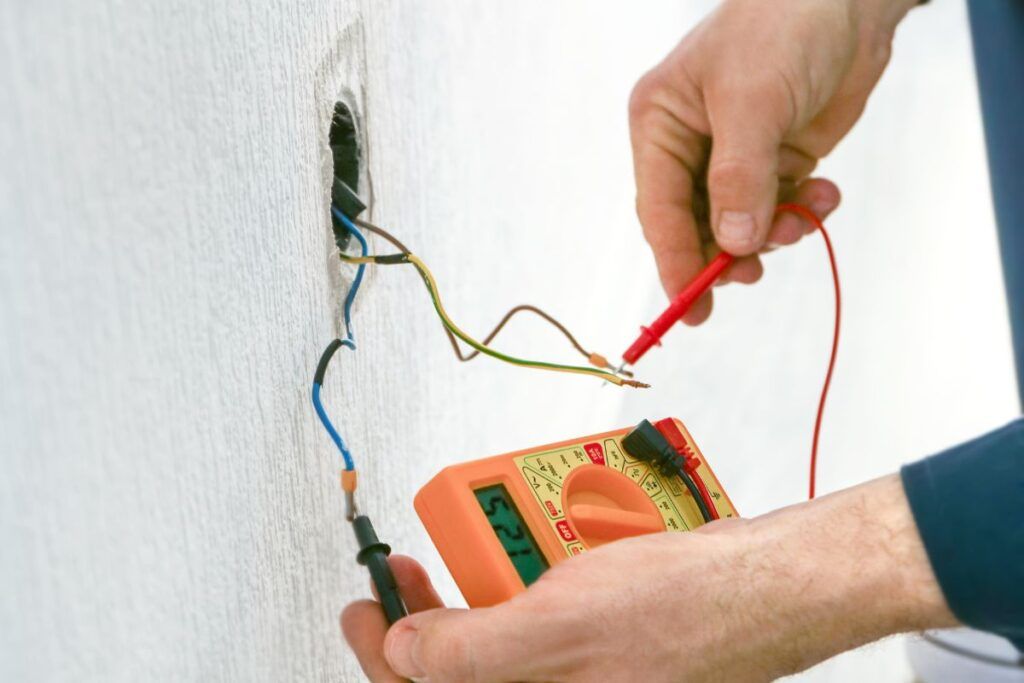The wire gauge numbers and their current carrying capacity is very confusing. Only the NEC codes can tell you the gauge wire numbers and their capacity. Today, we will talk about the amperage capacity of 16 gauge wires.
A 16 gauge wire can carry up to 13 Amps of current. Under certain circumstances, it might extend to 15 amps, but it can be risky as the wires overheat. Thus, these wires are usually avoided in residential wiring. They are mostly used in led ambient lighting, parking light, and automobile wiring.
The NEC codes have discussed very little about the uses of 16 gauge wires. But don’t worry, as we will take you through the usages, amperage, and wattage capacity of 16 gauge wires. So, stick to the end.

Check out our list of top-handpicked products for all your electrical, appliance, and HVAC system needs to keep your home running smoothly.
This post includes some affiliate links.What is a 16 gauge wire?
The 16 gauge wires are generally used for appliances with little electricity.
Since the wire handles only low currents, the wire is also good for light-duty extension cables.
The wires are used in everyday electrical devices like holiday lights, hedge trimmers, radios, etc.
The wire carries only 13 amps and is used for 50 feet only, which can power both indoor and outdoor appliances.
How many amps can a 16 gauge wire handle?
In general, the 16 gauge wires will handle only 13 amps.
But do not get disappointed due to its low amperage capacity.
You can still use the wires in various useful appliances.
The amount of load handled by the 16 gauge wires is quite distinctive.
The relationship between the wire size and current flow is very inverse.
That is why the current flowing through the wire is proportional to the wire size.
If you want the wire to carry more current, you need some low-number gauges, like 10 or 12.
Remember that the wire’s diameter is just the opposite of the gauge number.
The smaller gauge numbers are thicker than the bigger gauge number.
For example, a 12 gauge wire is much better than a 16 gauge wire.
A 12 gauge wire is thicker than a 16 gauge wire.
So, the 12 gauge can carry more current than a 16 gauge wire.
According to NEC, the 16 gauge wires can carry only 13 amp current loads.
You can also use it for 15 amps with some considerations.
Will a 16 gauge wire carry 10 amps?
The wire is capable of carrying at least 13 amps.
So, it will easily handle 10 amps.
Besides, the wire will never heat up or melt in a 10 amp circuit or appliance.
An 18-gauge wire carries current loads between 3 and 15 amps.
If an 18 gauge wire can handle such amps, then a 16 gauge wire will easily handle 10 amps without overheating.
If you have a 10 amp circuit or appliances, you can opt for 16 or 18-gauge wires.
Will a 16 gauge wire handle 15 amps?
A 16 gauge wire is designed to carry up to 13 amps current loads.
On the contrary, an 18 gauge wire easily carries current loads between 3 and 15 amps without trouble.
You can easily use a 16 gauge wire on a circuit or device that carries 15 amps.
However, it would be best if you use copper wires.
Since the amps have exceeded 13, the wire may overheat if the conductivity is poor.
Can 16 gauge wires handle 20 Amps?
The 16 gauge wires are not made for 20 amps.
The best wire gauge for 20 amp is 12 gauge wires.
Since the 16 gauge wire can handle only up to 13 amps, 20 amps will overheat the wires, and melt the insulation, resulting in a fire hazard.
Even if you use copper wires, they will still melt to current overflow.
If you have any appliances with 20 amps, use a 12-gauge wire.
How many amps with a 16 gauge wire handle at 12 volts?
At 12 volts, the 16 gauge wires will handle only 10 amps.
If 1 amp = 120 volts, then 12 volts = 0.8333 amps
Multiplying the volt and amp in a 16 gauge wire that carries 13 amp of current load will yield the voltage in the wire.
At 120 volts, a 16 gauge wire having 13 amps current capacity will be multiplied by 0.833 amps.
An outlet with 12 volts will emit 12 volts of electrical energy.
When you use a device with such voltages, the maximum amp the 16 gauge wires can handle will be only 10.
The wire size is proportional to the current capacity carried in the volts.
Understanding the wire gauges, voltage, and amp loads is very confusing.
Sometimes the current transferred by the 16 gauge wire at 12 volts can be 10 amps.
The current gets lost or evaporated when it transfers from one point to another through the wire.
It is caused due to the voltage drop.
So, the amp can be around 8.
The remaining voltage after current evaporation normally works as a safety valve in the power surge.
How far can I run a 16 gauge wire before the voltage drops?

Usually, a 300-watt transformer can power 100 feet of distance using a 16 gauge wire. But, it highly depends on voltage drop.
The voltage drop in a 10 amp load at 100 feet using a 16 gauge wire is 8 volts. At 10 feet, the drop will be 0.08 volts.
The maximum length for 16 gauge wire is 48 feet before the voltage drop begins.
If the voltage drop per 10 feet is 0.08 volts, calculate the voltage drop at 300 feet by dividing the distance by 100. The result will be 24 volts.
So, it suggests that the 16 gauge wires are not good for use in longer distances.
The distance sometimes depends on the amperage of the different applications, for example:
- 3 feet for 50 amps
- 5 feet for 30 amps
- 10 feet for distances between 18-30 feet
- 20 feet for 8-12 amps
- 25 feet for 8 to 10 amps
As you can see, you can use the wires for higher amps. How?
The distance is small.
For smaller distances, you require shorter wires.
Shorter wires have less resistance.
So, even if you use shorter 16 gauge wires in higher amps exceeding 15 amps, the chances of overheating and melted insulation are less.
The lower the resistance, the lower the chances of overheating.
How much wattage can a 16 gauge wire handle?
The wattage depends on which appliance you use the 16 gauge wire and what wattage it contains.
So, you need to multiply the voltage of the appliance and its amp.
If you are running the 16 gauge at an appliance that carries 10 amps at 120 volts, the result will be 1,200 watts.
At 240 volts, the wire will handle 2,400 volts.
At 480 volts, the wire will carry 4,800 volts.
If you are running the wire at 13 amps, then the wire will carry:
- 1,560 watts at 120 volts
- 3,120 watts at 240 volts
- 6,240 watts at 480 volts
Where can you use 16 gauge wires?
While choosing a wire gauge for a particular application, you must consider the wire material and temperature rating.
The commonly used wires are copper and aluminum.
Another one of copper-clad aluminum.
Copper wires are the best type of wires because:
- They are highly conductive. The wires carry loads of currents without overheating the wires. So, there are fewer chances of wire melts.
- The copper wires are durable and malleable. So, there are no risks of breakage.
- The wires do not expand or contract, so you can use them for longer distances without facing any interruption in the current flow.
But, the wire is very expensive.
Aluminum wires do not have good conductivity and durability like copper wires.
Besides, the wires can easily break.
Its contraction and expansion interrupt the easy current flow.
But, people still use aluminum wires because the wires are cheaper and easy to install and handle.
Copper-clad aluminum is also good because its ends have copper fittings which give slightly copper benefits.
The maximum amp limit of 16 gauge wire is 13 amps.
But, you can try using a 16 gauge copper wire for 15 amps.
If the wire is a little shorter, the wire can easily handle 15 amps.
Do not ever try using aluminum wires at devices where the amp can exceed 13 amps.
The best would be a 10 gauge wire.
Where to use copper wires?

A 16 gauge wire is generally used for extension cords, but you can also use them in other applications.
You can use 16 gauge copper wires in:
- Headlights
- Ambient light
- Parking lights
- Ignition coil
- Turn signals
- Alternators
- Interior lights
Can I use aluminum wires?
Aluminum wires are quite weaker than copper wires.
That is why some people use copper-clad aluminum wires.
But, whatever you use, the gauge wire for both wires will be the same.
Aluminum contains an oxide layer on its surface.
The wire creates the layer as the current passes through the wire, thus making an effective resistor.
You will rarely find 16 gauge wires made of aluminum.
If you want to match 16 gauge copper wires with a temperature rating of 90°C that pulls 15-18 amps, you need a 12 gauge aluminum wire that can pull at least 20 amps.
The amp will increase to 25 amps when the temperature rating is 90°C.
The 12 gauge aluminum wires are thicker than the 16 gauge wires.
So, it will handle better current than the 16 gauges.
Where else can you use 16 gauge wires?
You can also use the 16 gauge wires in home theater systems and car audio elements.
You can even use the wires in audio speakers where the speakers do not require separation.
The 16 gauge wires will not work very well if they are used for very long distances.
8 and 16-ohm speakers are also ideal for 16-gauge wires.
Can you join 16 gauge wire with 18 or 14 gauge wire?
The minimum wire size for alternating current is 14 gauge wire.
This wire will carry more current than a 16 gauge wire.
So joining 14 gauge wire with 16 gauge wire in the same circuit is hazardous.
But, joining 14,16, and 18 gauge wires in audio applications or inside a vehicle is fine, as long as the wires are well-insulated.
Like the 16 gauge wires, you should use the 18 gauge wires in automobiles, audio applications, and direct current battery power.
16 and 18-gauge wires are not listed in the NEC articles from 310 to 316.
The 16 amps wires are only used when the temperature rated at 90°C can pull 18 amps.
Final thoughts
The best amp for 16 gauge wire is 13 amps. To some extent, you can use it for 15 amps, provided the wire is copper, and the length is shorter. Otherwise, 13 amps are the maximum limit.
You can also use it for 10 amps. The wire will work safely at a proper distance without any overheating.
The 16 gauge wire can also handle higher amps if the distances are shorter, like 50 amps up to 3 feet or 30 amps up to 5 feet.
You can use the 16 gauge wires in headlights, parking lights, alternators, and audio speakers.
You can even join the 16 and 18 or 14-gauge wires in audio applications, but not in a circuit or appliance that pulls excessive current.
Data Source: National Electrical Code, NEC Wire Table, Electrical wiring, Home wiring.


